This is Mike Strong, in Hays, for HPPR. The book is On The Great Highway: The Wanderings and Adventures of a Special Correspondent (1901) by James Creelman.
In the 1970’s, Hunter S. Thompson, would take on the label of “Gonzo” journalist, calling it a “style of ‘reporting’ based on William Faulkener’s idea that the best fiction is far more true than any kind of journalism.” (ref “Gonzo” page 022 top left paragraph)
In the 1890’s, James Creelman, and his sometimes Hearst stablemate, Richard Harding Davis, inserted themselves as central narrative characters in their journalism which often resembled dime novels. Neither was shy about embellishment.
In “On the Great Highway” James Creelman evangelizes yellow journalism with a full chapter, chapter IX, “Familiar Glimpses of Yellow Journalism.” In the first paragraph, Creelman calls it,
that form of American journalistic energy which is not content merely to print a daily record of history, but seeks to take part in events as an active and sometimes decisive agent.
Warming to his theme, Creelman continues,
… when the world accepted the emancipation of Cuba from the bloody rule of Spain as a glorious step in the progress of mankind, — then the part played by the newspapers was forgotten, and “yellow journalism” was left to sing its own praises; …
And yet no true history of the war which banished Spain from the western hemisphere and released the Philippine archipelago from her tyranny, can be written without an acknowledgment that whatever of justice and freedom and progress was accomplished by the Spanish-American war was due to the enterprise and tenacity of “yellow journalists,” many of whom lie in unremembered graves.
From boastful passages like that it is not hard to see where the idea that media can control governments comes from. Creelman spends another page or two then hands out his “furnish the war” claim. In contrast, the impetus to war really came from other circumstances. To congress and others in government the newspapers were little more than an irritation. To give newspapers credit for turning out the troops and waging a war you need a mechanism by which newspapers can do so. There is no such mechanism.
To make a claim on the success of yellow journalism, Creelman recounts the “rescue of the beautiful Evangelina Cisneros from a Havana prison by the Journal’s gallant correspondent, Karl Decker. There is nothing in fiction more romantic than this feat of ‘yellow journalism.’“
This rescue generated interest in Cuba and her status. This is August 1897.
Newspapers took up the cause of “the beautiful Evangelina Cisneros” along with the Spanish Queen Regent and the Pope. But it is “gallant correspondent, Karl Decker” of The Journal who sneaks Ms. Cisneros out of the prison, then disguises her as a boy to get her on a steamer for New York.
By comparison, “Gonzo” journalism, as practiced by Hunter S Thompson, was more self-interested, personal, drug and alcohol fueled, free spinning, hedonistic, class-clown invasive. Sentences like this pull you in, “We were somewhere around Barstow on the edge of the desert when the drugs began to take hold.”
And Thompson compared politics to heroin:
“There is a fantastic adrenaline high that comes with total involvement in almost any kind of fast-moving political campaign.” (from “Fear and Loathing on the Campaign Trail 1972)
For Creelman the perspective on politics was dime-novel hero stuff. For Thompson’s Gonzo, the perspective on politics was a drug trip. One embroiders facts and the other
embroiders instincts, and both are compelling.
This is Mike Strong, in Hays, for HPPR Radio Readers Book Club
REFERENCES
“Fear and Loathing in America” (2000)by Hunter S Thompson, Simon & Schuster









